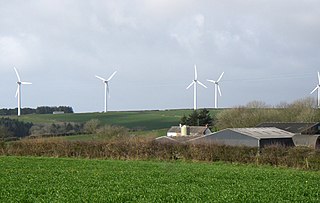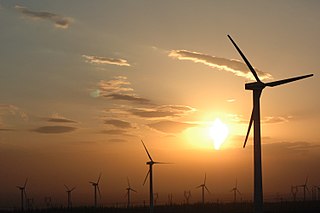Related Research Articles

Japan's primary energy consumption was 477.6 Mtoe in 2011, a decrease of 5% over the previous year. The country lacks significant domestic reserves of fossil fuel, except coal, and must import substantial amounts of crude oil, natural gas, and other energy resources, including uranium. Japan relied on oil imports to meet about 84% of its energy needs in 2010. Japan was also the first coal importer in 2010, with 187 Mt, and the first natural gas importer with 99 bcm. As of 2019, 88% of Japan's total primary energy supply came from fossil fuels.

Many countries and territories have installed significant solar power capacity into their electrical grids to supplement or provide an alternative to conventional energy sources. Solar power plants use one of two technologies:

Solar power is a fast-growing industry in Australia. As of September 2023, Australia's over 3.60 million solar PV installations had a combined capacity of 32.9 GW photovoltaic (PV) solar power, of which at least 3,823 MW were installed in the preceding 12 months. In 2019, 59 solar PV projects with a combined capacity of 2,881 MW were either under construction, constructed or due to start construction having reached financial closure. Solar accounted for 12.4% of Australia's total electrical energy production in 2021.

The production of renewable energy in Scotland is a topic that came to the fore in technical, economic, and political terms during the opening years of the 21st century. The natural resource base for renewable energy is high by European, and even global standards, with the most important potential sources being wind, wave, and tide. Renewables generate almost all of Scotland's electricity, mostly from the country's wind power.
For solar power, South Asia has the ideal combination of both high solar insolation and a high density of potential customers.

China is both the world's largest energy consumer and the largest industrial country, and ensuring adequate energy supply to sustain economic growth has been a core concern of the Chinese Government since the founding of the People's Republic of China in 1949. Since the country's industrialization in the 1960s, China is currently the world's largest emitter of greenhouse gases, and coal in China is a major cause of global warming. However, from 2010 to 2015 China reduced energy consumption per unit of GDP by 18%, and CO2 emissions per unit of GDP by 20%. On a per-capita basis, China was only the world's 51st largest emitter of greenhouse gases in 2016. China is also the world's largest renewable energy producer, and the largest producer of hydroelectricity, solar power and wind power in the world. The energy policy of China is connected to its industrial policy, where the goals of China's industrial production dictate its energy demand managements.

Renewable energy in the United Kingdom contributes to production for electricity, heat, and transport.

China is the world's leader in electricity production from renewable energy sources, with over triple the generation of the second-ranking country, the United States. China's renewable energy sector is growing faster than its fossil fuels and nuclear power capacity, and is expected to contribute 43 per cent of global renewable capacity growth. China's total renewable energy capacity exceeded 1,000 GW in 2021, accounting for 43.5 per cent of the country's total power generation capacity, 10.2 percentage points higher than in 2015. The country aims to have 80 per cent of its total energy mix come from non-fossil fuel sources by 2060, and achieve a combined 1,200 GW of solar and wind capacity by 2030. In 2023, it was reported that China was on track to reach 1,371 gigawatts of wind and solar by 2025, five years ahead of target due to new renewables installations breaking records.

China is the world leader in wind power generation, with the largest installed capacity of any nation and continued rapid growth in new wind facilities. With its large land mass and long coastline, China has exceptional wind power resources: Wind power remained China's third-largest source of electricity at the end of 2021, accounting for 7.5% of total power generation.

China is the largest market in the world for both photovoltaics and solar thermal energy. China's photovoltaic industry began by making panels for satellites, and transitioned to the manufacture of domestic panels in the late 1990s. After substantial government incentives were introduced in 2011, China's solar power market grew dramatically: the country became the world's leading installer of photovoltaics in 2013. China surpassed Germany as the world's largest producer of photovoltaic energy in 2015, and became the first country to have over 100 GW of total installed photovoltaic capacity in 2017.

The renewable-energy industry is the part of the energy industry focusing on new and appropriate renewable energy technologies. Investors worldwide have paid greater attention to this emerging industry in recent years. In many cases, this has translated into rapid renewable energy commercialization and considerable industry expansion. The wind power, solar power and hydroelectric power industries provide good examples of this.

China is the world's largest electricity producer, having overtaken the United States in 2011 after rapid growth since the early 1990s. In 2021, China produced 8.5 petawatt-hour (Pwh) of electricity, approximately 30% of the world's electricity production.

India is world's 4th largest consumer of electricity and world's 3rd largest renewable energy producer with 40% of energy capacity installed in the year 2022 coming from renewable sources. Ernst & Young's (EY) 2021 Renewable Energy Country Attractiveness Index (RECAI) ranked India 3rd behind USA and China. In FY2023-24, India is planning to issue 50 GW tenders for wind, solar and hybrid projects. India has committed for a goal of 500 GW renewable energy capacity by 2030. In line with this commitment, India's installed renewable energy capacity has been experiencing a steady upward trend. From 94.4 GW in 2021, the capacity has gone up to 119.1 GW in 2023 as of Q4.

As of 2019, renewable energy in Morocco covered 35% of the country’s electricity needs.

Enel Green Power S.p.A. is an Italian multinational renewable energy corporation, headquartered in Rome. The company was formed as a subsidiary of the power generation firm Enel in December 2008. It has operations in five continents generating energy from solar, geothermal, wind and hydropower sources. As of 2022, it manages a capacity of 60,9 GW and has over 1200 plants worldwide.
Renewable energy in Thailand is a developing sector that addresses the country’s present high rate of carbon emissions. Several policies, such as the Thirteenth Plan or the Alternative Energy Development Plan, set future goals for increasing the capacity of renewable energy and reduce the reliance of nonrenewable energy. The major sources of renewable energy in Thailand are hydro power, solar power, wind power, and biomass, with biomass currently accounting for the majority of production. Thailand’s growth is hoped to lead to renewable energy cost reduction and increased investment.

Renewables supply a quarter of energy in Turkey, including heat and electricity. Some houses have rooftop solar water heating, and hot water from underground warms many spas and greenhouses. In parts of the west hot rocks are shallow enough to generate electricity as well as heat. Wind turbines, also mainly near western cities and industry, generate a tenth of Turkey’s electricity. Hydropower, mostly from dams in the east, is the only modern renewable energy which is fully exploited. Hydropower averages about a fifth of the country's electricity, but much less in drought years. Apart from wind and hydro, other renewables; such as geothermal, solar and biogas; together generated almost a tenth of Turkey’s electricity in 2022. Türkiye has ranked 5th in Europe and 12th in the world in terms of installed capacity in renewable energy. The share of renewables in Türkiye’s installed power reached to 54% at the end of 2022.
Neoen is a French producer of exclusively renewable energy headquartered in Paris, France. Founded in 2008, it develops, finances, builds and operates solar power plants, wind farms and energy storage solutions. As at 30 June 2023, the company's total capacity was 7 GW, made up of 47% solar, 34% wind and 19% battery storage. Neoen aims to attain 10 GW in operation or under construction by 2025.
Green hydrogen (GH2 or GH2) is hydrogen produced by the electrolysis of water, using renewable electricity. Production of green hydrogen causes significantly lower greenhouse gas emissions than production of grey hydrogen, which is derived from fossil fuels without carbon capture.
The Asian Renewable Energy Hub (AREH) is a proposal to create one of the world's largest renewable energy plants, in the Pilbara region of Western Australia. It was first proposed in 2014, with plans for the project concept changing several times since then. As of June 2022, the project developers BP, Intercontinental Energy, CWP Global, Vestas, and Pathway Investments were planning to build a mixture of wind power and solar energy power generators which would generate up to 26 gigawatts of power.
References
- ↑ "Green fuels mega project set to make Oman world leader in green hydrogen and green ammonia | OQ". oq.com. Retrieved 2021-10-14.
- ↑ 이치동 (2021-02-05). "Moon attends ceremony on world's largest sea wind power complex project". Yonhap News Agency. Retrieved 2021-10-14.
- ↑ "About the Asian Renewable Energy Hub – Asian Renewable Energy Hub". asianrehub.com. Archived from the original on May 8, 2021. Retrieved 2021-10-14.
{{cite web}}: CS1 maint: unfit URL (link) - ↑ www.DonPig.com. "Western-green-energy-hub | InterContinental Energy". intercontinentalenergy.com. Retrieved 2021-10-14.
- ↑ "China building 100 GW of wind and solar somewhere in the desert - report". Renewablesnow.com. Retrieved 2021-10-14.
- ↑ "The plans for the world's biggest solar farm just got 40 per cent bigger". ABC News. 2021-09-23. Retrieved 2021-10-14.
- ↑ Warner, Jeroen; Jomantas, Sarunas; Jones, Eliot; Ansari, Md Sazzad; de Vries, Lotje (March 2019). "The Fantasy of the Grand Inga Hydroelectric Project on the River Congo". Water. 11 (3): 407. doi: 10.3390/w11030407 .
- ↑ "The world's largest onshore single wind power project generates electricity--Seetao". www.facebook.com. Retrieved 2021-10-14.
- ↑ "From Sand to Solar: China's Gigawatt Revolution in the Kubuqi Desert". Power Systems Technology. Retrieved 2024-01-30.
- ↑ "Morocco-UK Power Project". Xlinks. Retrieved 2021-10-18.